Classification Summary
The coastal classification maps provide a basis for establishing the lengths of shore that have a particular morphological characteristic or urban attribute. Such information is relevant for local and state governments for planning that involves the amount of shore that is developed versus undeveloped, or the amount of parkland held in the public trust. Also, there is interest regarding the amount of shore that is affected by engineering structures, referred to as armoring or hardening of the shore. Environmental-protection and resource-management issues such as these require quantitative data that can be derived from the classification maps.
The shore lengths and equivalent percents of the 149.6-km-long segment of coast between Aransas Pass and Mansfield Channel are presented for each classification unit in Table 2. Ninety three percent of this coastal segment is undeveloped, and where it is developed, the development is mostly low to moderate density (Table 2). Single-family homes are slightly less common than multi-family units such as high-rise condominiums and hotels, and 78% of the shore is classified as parks (Table 2). This includes state and county parks as well as Padre Island National Seashore. About 75% of the shore has high continuous dunes and discontinuous dunes cover an additional 23% of the shore. Because the dunes are mainly continuous, complete overwash occurs only along 1% of the shore (Table 2). The closed inlet and new inlet categories (Table 2) refer, respectively, to the Fish Pass at Mustang Island State Park and the recently reopened Packery Channel that separates Mustang and North Padre Islands. Seventy six percent of the shore is characterized by natural beaches more than 30 m wide (Table 2); wide maintained beaches account for another 22% of the shore. Because the beaches are wide and mostly undeveloped, there is little need for shoreline stabilization structures. Only about 1% of the shore is influenced by hard structures (Table 2); the most extensive structure is the seawall built in the backbeach on North Padre Island.
| Table 2. Lengths of shore and percentages for the classification units mapped between Aransas Pass and Mansfield Channel. Total length of this coastal segment is about 149.6 km. |
| Category |
Classification |
Length (km) |
Percent |
Pie Chart |
| Overwash |
Overwash |
1.9 |
1 |
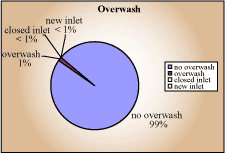 |
| Closed inlet |
0.1 |
<1 |
| New inlet |
0.1 |
<1 |
| No overwash |
147.5 |
99 |
| Dunes |
Absent |
1.3 |
1 |
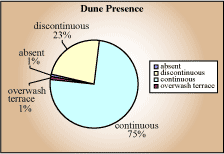 |
| Continuous |
112.0 |
75 |
| Discontinuous |
34.8 |
23 |
| Overwash terrace |
1.5 |
1 |
| Beach
width |
> 30 m natural |
113.6 |
76 |
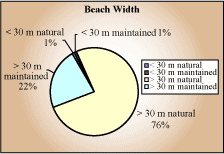 |
| > 30 m maintained |
33.6 |
22 |
| < 30 m natural |
1.2 |
1 |
| < 30 m maintained |
1.3 |
1 |
| Structures |
No structure |
148.0 |
99 |
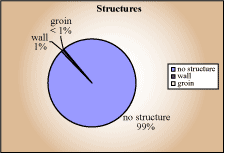 |
| Wall |
1.4 |
1 |
| Riprap |
0.0 |
0 |
| Groins |
0.2 |
<1% |
| Multiple structures |
0.0 |
0 |
| Development
Density |
Undeveloped |
138.5 |
93 |
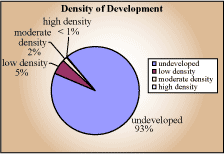 |
| Low density |
8.2 |
5 |
| Moderate density |
2.5 |
2 |
| High density |
0.4 |
<1 |
| Dwelling
Type |
No dwelling |
25.5 |
17 |
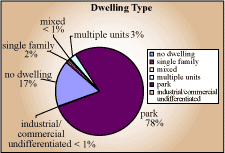 |
| Single family |
2.3 |
2 |
| Mixed |
0.7 |
<1 |
| Multi-unit |
3.7 |
3 |
| Park |
117.1 |
78 |
| Indust./Commercial |
0.4 |
<1 |
|
continue to: References
 |




